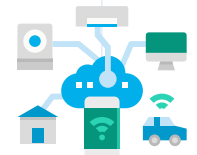Technically speaking, the Internet of Things (IoT) is the concept of connecting any device with an on/off switch to the internet and/or other connected devices – in such a way that the device(s) collect and share data about the way they are used and about the environment around them.
Today IoT has grown so much that 56 of 90 federal agencies reported using IoT technology in 2020.
Also, experts project the total installed IoT-connected devices worldwide to amount to 30.9 billion units by 2025
4 Components of IoT
- Connected Sensor (things)
- Gateway
- Connected
- Platform
Everything Connected
When it comes to compliance, every device connecting to a “compliant” IT network must follow security protocols outlined by compliance regulations and liability insurance agreements. Overlooking any connected devices creates a non-compliance incident that could be exploited and used to harm your organization. As you consider the impact of IoT in the work-from-home era, look into whether or not the following connected devices are in compliance with regulations you must follow to avoid costly fines:
Examples of IoT “smart” devices used in business:
- Printers and basic internet/Wi-Fi routers
- Webcams (built-in/connected) and speakers/sound systems
- Pacemakers and other medical IoT devices
- Assistant devices
- Smartwatches
- “Smart” televisions and thermostats
- Robotic floor cleaners
- Traffic cameras/sensors and water/electrical meters
- Connected IoT in vehicles
IoT Regulation Challenges
Regulators cannot ignore data protection and privacy matters of technology like IoT because an enormous amount of data is generated, processed and shared by IoT environments.
Here are a few standards through which regulators view IoT:
HIPAA
Just like any other industry, healthcare is rapidly adopting IoT technology. The combination of medicine and IoT has led to the term, the Internet of Medical Things (IoMT). IoMT uses sensor capabilities, big data analytics, etc., to provide improved medical care. Also, cyberattacks targeted healthcare more than any other industry in 2020.4 That’s why a regulation like the Health Insurance Portability and Accountability Act (HIPAA) is essential. One of the primary goals of HIPAA is to safeguard medical data, including Protected Health Information (PHI). You must inarguably comply with HIPAA if you are in the healthcare business.
GDPR
Most of the data-processing activities within the operational scope of IoT fall under the scrutiny of the European Union’s General Data Protection Regulation (GDPR). Being GDPR compliant shows that the business has met basic data protection standards. The GDPR covers both personal data and business-sensitive data. Therefore, it is vital for those who adopt IoT technology to be aware of the implications that the regulation will have on IoT devices, systems and applications. IoT Regulation Challenges
Compliance Keeps Theses in Check
About 60% of IoT devices are vulnerable to medium- or high-severity attacks.5
Over 95% of all IoT device traffic is unencrypted.5
About 72% of organizations experienced an increase in endpoint and IoT security
incidents last year and 56% of organizations expect a compromise via an endpoint or IoT-originated attack within the next 12 months.6
CMMC
The new Cybersecurity Maturity Model Certification (CMMC) requirements established by the Department of Defense (DoD) aim to prevent Defense Industrial Base (DIB) cyberattacks.
CMMC is relatively new and might take a few years more to completely roll out. However, regardless of whether they use IoT or not, all contractors must gear up for CMMC to avoid any last-minute hitches.
A single IoT device that does not comply with the law can invalidate your cyber insurance claims.
Being compliant comes with a lot of benefits—you can improve overall data safety, avoid potential criminal charges, improve public relations, prevent attrition and ensure insurance providers pay out cyber insurance claims in the event of an incident. If you have implemented a Bring Your Own Device (BYOD) policy within your business, you might have to evaluate the situation to ensure everything is compliant.
IoT-Related Risks and Threats
- Protecting data integrity and privacy against the growing risk of IoT device attacks has become a global priority. Here are some IoT-related risks and threats you’ll want to guard your devices against:
- Hackers exploit vulnerabilities in IoT devices and use them to access the entire network.
- Lack of proper security controls:
- • Even if software flaws are detected, you may not be able to patch an IoT device on time with security updates, leaving it exposed to risks.
- • Many Operational Technology (OT) systems are flat, lacking filtering choke points such as firewalls or router ACLs. It renders standard network remediation tactics ineffective when it comes to preventing the spread of malware and can sometimes trigger critical infrastructure disruptions/failures.
- • Most IoT networks lack even basic encryption systems for data in transit and
- data at rest.
- Some sensors collect (and potentially store and share) sensitive data without the user’s knowledge or permission.
- This could lead to industrial espionage and eavesdropping.
- There are no universal regulatory requirements or “standards” for manufacturing or security for IoT.
- Default password vulnerabilities are still a primary concern.
- IoT ecosystems are complex. A key challenge is that a “one size fits all” security policy or solution is not realistic or currently achievable.
- The lack of broad universal knowledge and awareness of IoT at the user level regarding functionality and risks.
- The wave of modern, connected, medical devices shows promise in improving patient care, gathering better clinical data, improving efficiency and reducing costs. However, they also come with the baggage of security risks, threats and vulnerabilities from technology,
- software, cloud and human factors. In addition:
- • Most medical devices run on commercial off-the-shelf (COTS) software like Linux,
- Windows and Oracle, which exposes them to the same vulnerabilities that those
- programs already have.
- • Manufacturers are still regularly using old technologies that do not comply with
- modern digital landscape requirements
IoT Compliance Regulations
With a focus on IoT-related consumer protection, government authorities from different countries are attempting to regulate this technology.
Many regulatory bodies at the state and federal levels have drafted IoT security bills designed to hold product manufacturers accountable for consumer device security. This new wave of IoT regulations is prompting manufacturers to consider ways to enhance their device security programs to include business-grade and enterprise-level IoT security features.
Here’s a list of country-specific regulations and initiatives:
United States
• Federal IoT Cybersecurity Improvement Act (Law: December 4, 2020)
• There are two additional state-sanctioned bills, which are:
The SB-327 from California, also known as the “IoT bill.”
The state of Oregon’s bill relating to security measures required for devices connected to the internet.
Canada
Canadian Multistakeholder Process: Enhancing IoT Security initiative
Europe/EU
The EU Cybersecurity Act (2019)
Japan
Basic Act of Cybersecurity & New Cybersecurity Strategy (2018)
– This cybersecurity guidance released by the Japanese government
includes 51 references to use cases and best practices for IoT.
Components of the Global Regulation Wave Surrounding IoT Product Security
According to the new wave of regulations, all IoT device manufacturers will have to comply with the .
01 Prioritize Governance
There must be effective governance to promote standardization. Regularly monitoring regulatory risks is also essential.
02 Conduct Thorough Risk Assessment
It is crucial to detect the risks posed by connected devices to your organization’s operations/assets and stakeholders, including customers.
03 Configuration Management
Standardize configuration management to ensure the best configuration is present in IoT devices.
Identity Management and Access Control
04 Identity Management and Access Control
Only authorized people should have access to IoT devices, data and networks.
05 Data management and privacy
Manufactures are responsible for implementing methods to protect generated stored and transmitted by device
06 Vulnerability Monitoring and Patching
Regularly monitor, detect and resolve security problems in the devices.
Can your business afford to continue to use none compliant devices
The Cost of Ignoring IoT Compliance Risks
If you are under the impression that you can get away with not complying with regulations, you are mistaken. Keep in mind that being non-compliant can land your business in hot water Can your business afford to continue to use non-compliant IoT devices?
01 Hefty penalties
HIPAA violations can draw fines ranging from $100 to $50,000 per violation, with a maximum fine of $1.5 million per calendar year of non-compliance.7 GDPR violations lead to hefty violation fines worth 2% to 4% or more of company turnover based on the severity of neglect.8
02 Uninvited audits
Non-compliance can lead to unpleasant inspections and audits that can lead to fines
03 Denial of cyber insurance claims Identity Management and Access Control
Only authorized people should have access to IoT devices, data and networks.
Be extra careful when selecting IoT solutions for your business. Using a single non-compliant solution can cause your insurance provider to deny a cyber insurance claim.
04 Loss of business reputation
Remember, it takes years to build a reputation and just minutes to ruin it.
05 Imprisonment or even forced closure.
In cases of severe non-compliance, regulatory bodies can sanction the arrest of top executives or even close the business.

